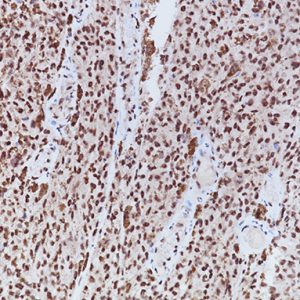Description
This antibody reacts with human Glial Fibrillary Acidic Protein antibody and does not react with other intermediate filaments. Anti-GFAP stains astrocytes, ependymal cells and corresponding tumors. In the peripheral nervous system, GFAP stains Schwann cells, enteric glial cells and satellite cells. Weak staining of axons has been observed which is caused by cross-reaction with neurofilament. Studies have shown GFAP may be useful for distinguishing neoplasms of astrocytic origin from other neoplasms in the central nervous system. Negative staining has been observed with lymphatic tissue, muscle, gastrointestinal tract, liver, kidney, pancreas and bladder.
SPECIFICATIONS
Specifications
| WEIGHT | N/A |
|---|---|
| DIMENSIONS | N/A |
| INTENDED USE | IVD |
| SPECIES REACTIVITY | Human, Mouse, Rat |
| SOURCE | Rabbit Polyclonal |
| CLONE | N/A |
| ISOTYPE | N/A |
| ANTIGEN | Glial Fibrillary Acidic Protein |
| LOCALIZATION | Cytoplasmic |
| POSITIVE CONTROL | Normal brain or astrocytoma |
DATASHEETS & SDS
INTERNATIONAL
REFERENCES
1. Huang MC, Kubo O, Tajika Y, Takakura K. A clinico-immunohistochemical study of giant cell glioblastoma. Noshuyo Byori 1996 Apr;13(1):11-16.
2. Xu KP, Liu SL, Ni C. Immunohistochemical evidence of neuronal and glial differentiation in retinoblastoma. Br J Opthalmol 1995 Aug;79(8):771-776.
3. Korshunov AG, Sycheva RV. Expression of glial fibrillary acidic protein and protein S-100 in cerebral astrocytic gliomas of varying degrees of malignancy. Arkh Patol 1995 Jul;57(4):30-38.
4. McLendon RE, Bigner DD. Immunohistochemistry of the glial fibrillary acidic protein: basic and appliedconsiderations. Brain Pathol 1994 Jul;4(3):221-228.
5. Xu QZ, Duan HL, Lu DH. Immunohistochemical quantitative study of glial fibrillary acid protein and vimentin astrocytomas. Chuang-hua Ping Li Hsueh Tsa Chih 1994 Apr;23(2):66-68.
6. Center for Disease Control Manual. Guide: Safety Management, NO. CDC-22, Atlanta, GA. April 30, 1976 “Decontamination of Laboratory Sink Drains to Remove Azide Salts.”
7. National Committee for Clinical Laboratory Standards (NCCLS). Protection of laboratory workers from infectious diseases transmitted by blood and tissue; proposed guideline. Villanova, PA 1991;7(9). Order code M29-P.







Reviews
There are no reviews yet.